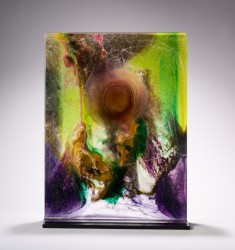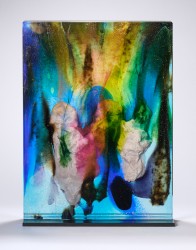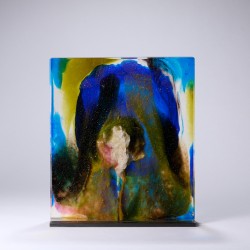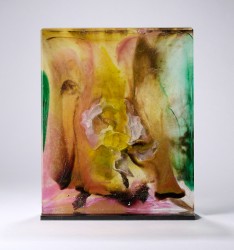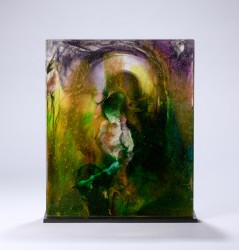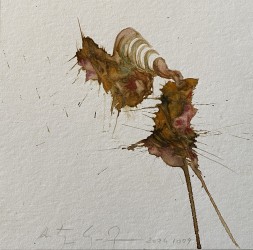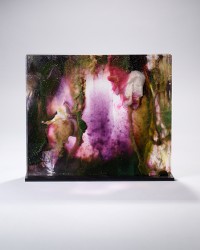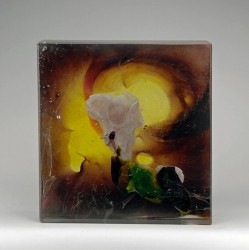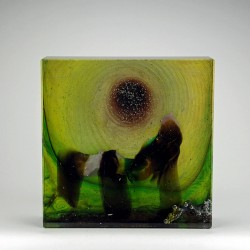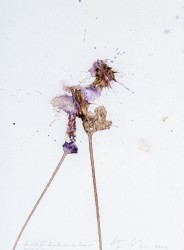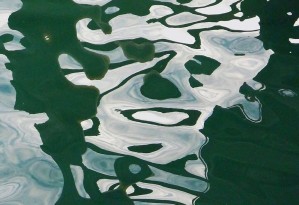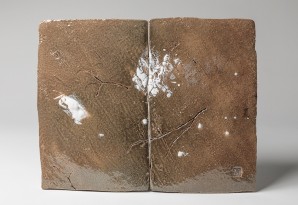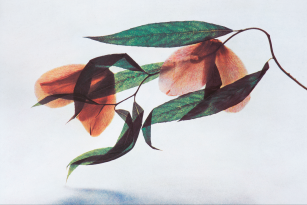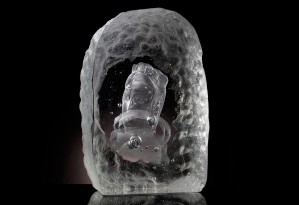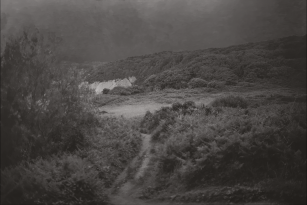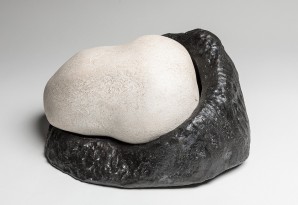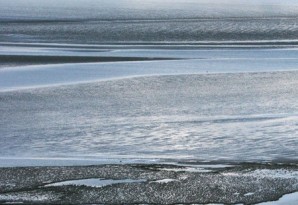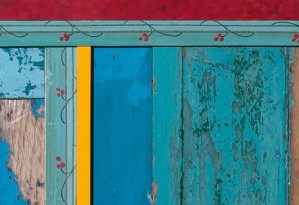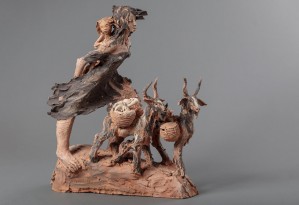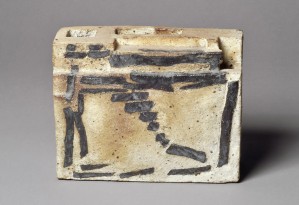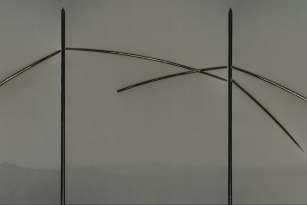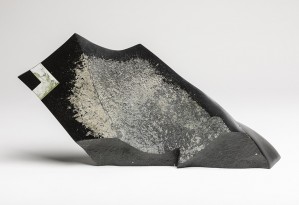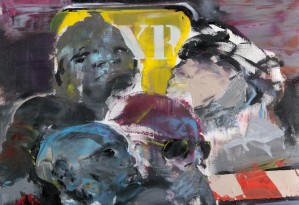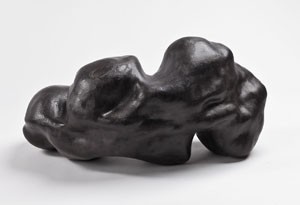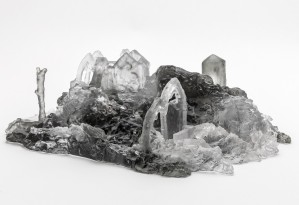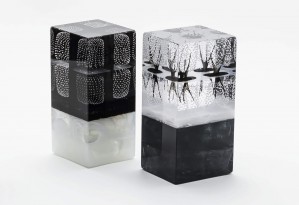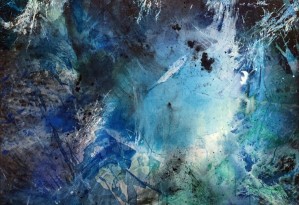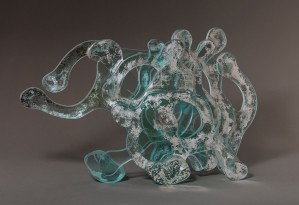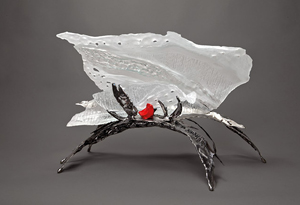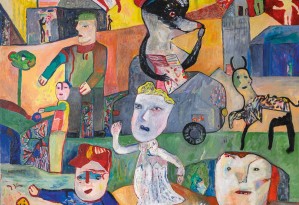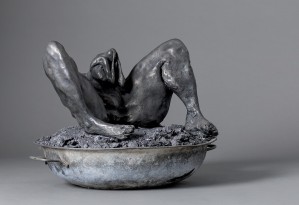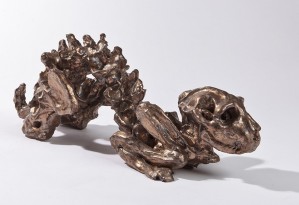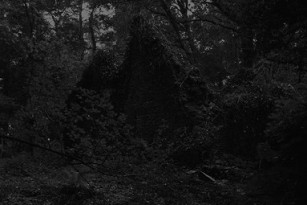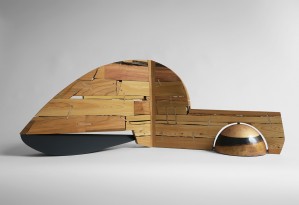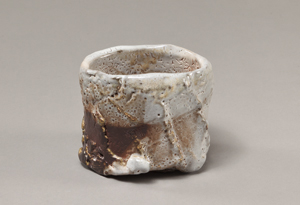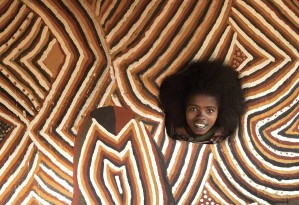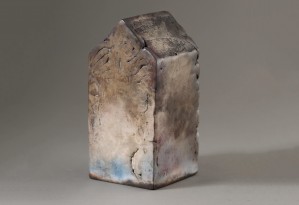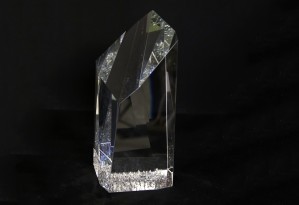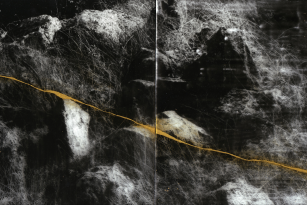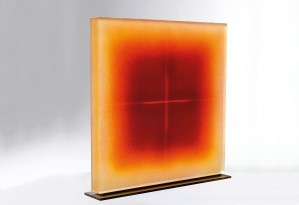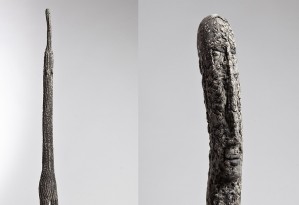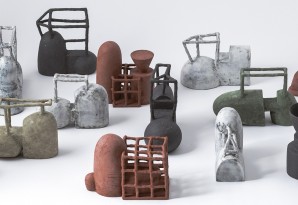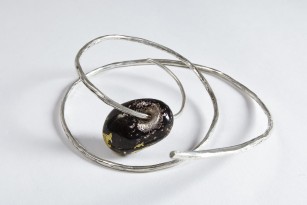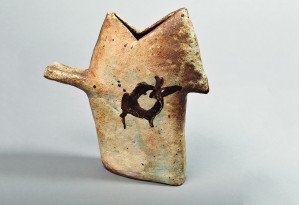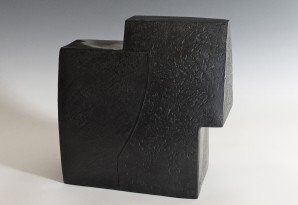LEPERLIER Antoine, glass sculpture, permanent artist of Galerie Capazza since 1981
The suspended sparkle. Antoine Leperlier or the memory of glass
There are materials that capture light without ever rendering it intact, surfaces where the visible hardly ever reveals itself, where the image, without ever imposing itself, becomes blurred and erased. Antoine Leperlier's glass belongs to this line of indecisive elements, endowed with an unsuspected memory. It is neither pure brilliance, nor a faithful mirror: it is an edge, a membrane where traces are deposited, where forms are not imprinted, but rather veiled, sketched and revealed in turn, in an alchemy of reticence and appearance.
The artist does not model, engrave or paint; he watches for the moment when the element, in the intensity of fusion and the patience of cooling, becomes a vision. Not a gesture of imprint, but a vigil. This relationship is not that of a sovereign demiurge imposing his will. Rather, it is that of a watchman who gives chance to chance. Through variations in temperature, internal tensions in the silica and subtle chromatic transformations, he allows the unexpected to emerge, recording the birth of the vestige as if it were a natural, unpredictable phenomenon.
Color, on the other hand, is not deposited on the surface, but transpires and buries itself in the very thickness. Neither totally reflected nor fully absorbed, it is sedimented in minute strata, like a chromia in latency, where each variation in the glass registers a hue, a luminous temporality that never ceases to recompose itself as the material modulates.
Crack or spurt? Accident is not chaos, but an active principle. As Francis Bacon evoked for painting, accident here becomes an intelligence of its own that, far from thwarting the project, enhances its intensity. With Leperlier, the image doesn't just happen, it insists. In this sense, he does not show us a world of objects, but a particular regime of existence; not a simple phenomenology of the visible, but an ontology of the uncertain.
Each piece is an interval, a living vestige. Let us judge: Leperlier works with glass as a haunted surface, where forms return, spectral; he thinks of his art as a meditation on memory, a work where the mark, no longer mere figuration, becomes the persistence of a bygone moment. Glass, with its captivating transparency, becomes the site of a sensitive archaeology, where the invisible meanders in a petrified fluid. Each piece is a crystallized enigma, where contours undulate in a vibration, itself caught in the trap of solidity.
This brings to mind the Veronica, the miraculous veil on which the face of Christ is said to have been imprinted, not traced by human hands, but attested in the urgency of contact. From this legend, Leperlier retains this cardinal question: what is an image that emanates not from the eye, but from touch? A plastic event born not from a pencil or a brush, but from the shock and interaction between a body and a material? Contrary to traditional representations, he invites us to think of the image not as a construction, but as an emergence that resists permanence and always remains in suspense.
His fascination with the wooden ymagiers of his ancestors is not the result of a simple artisanal filiation, but of a process in which touch, trace and remanence prevail over mimetic intentionality. Here, memory does not freeze: it diffracts, dissolves and reappears as the light shines through it and the eye brushes against it. No constructed representation. Rather, an involuntary apparition, a three-dimensional Veronique, where contact becomes an image matrix, not an act of figuration.
Leperlier turns the classical paradigm of the print as a simple reproduction of reality on its head: it does not copy, but retains an absence. Glass, with its density and translucency, exacerbates this tension: what it holds out to us is a haunting of the gaze, hesitating between the given and the lost, the legible and the illegible.
And it is this dialectic that gives this work its poetic force; glass is a capricious material, animated by secret tensions: passage from liquid to solid state, latent flows that agitate it under the effect of fire, cooling that transits these movements in an ever unstable equilibrium, between mastery and abandonment. The artist does not tame it, but accompanies it, without ever imposing definitive forms. As a result, his pieces are not closed objects, but open phenomena, suspended in evanescence.
As a hybrid material, long relegated to the status of a craft, confined to the realm of the decorative, glass has had to struggle to extricate itself from classifications and claim a place among the mediums of contemporary art. But Leperlier doesn't legitimize it as a conceptual artifice, nor as “major” art. He invests it as a territory, with its own constraints and memories.
Antoine Leperlier's commitment goes beyond mere aesthetics. Claiming that working with glass is an intellectual act in its own right, he challenges the academic structures that compartmentalize creation. This approach echoes the thinking of Asger Jorn and the avant-garde movement that, as early as the Bauhaus, sought to reconcile gesture and idea, hand and mind.
But Leperlier goes further: not only does he advocate the rehabilitation of making, he also reveals light itself as a mode of thought, a language capable of accommodating visions that the intellect alone could not generate. As a result, his work is part of a genealogy in which the material becomes an archive of time, extending the reflections of modern and contemporary art on the sedimentation of the visible.
Leperlier is not a sculptor, but a passer d'éclats. With him, the trace trembles, the world itself wavers. His art doesn't capture time, it opens it up: a crack where matter trembles between appearance and erasure. And in this breach, it's not just the image that becomes blurred, it's our own gaze-turned-imprint.
Paloma Hermina Hidalgo
Paris, february 2025
VEDUTA INTERNA
Mental images have always fascinated me by their fluid immateriality: they impose themselves on our consciousness with an undeniable presence, then vanish in time without leaving a trace, even if they sometimes persist within us. Trying to suspend them in order to retain the vision, while knowing that they will disappear, is as futile an attempt as holding water or sand between the fingers - a way, in short, of trying to stop time in order to see better. However, glass, of all the artistic media, seems to me to be the one with the best qualities for capturing moving, uncertain images. Its transparency allows us to access the singular density of images projected in a kind of material metaphor of mental space.
As they move from a fluid to a solid state - marked by the gradual slowing down of the internal movements of the molten material - the colors I've arranged in the mold coagulate into images in the three dimensions of the transparent mass, in a slow, chaotic process. As they move, the colors fuse, repel or superimpose each other according to complex physical laws linked to their viscosity, density or convection phenomena. In a way, glass spontaneously “paints” in volume and composes without intention under the regime of chance, which I rely on to order the molten chaos and create these internal vedutes, like views into the inner world of matter. In this laboratory of “dream stones”, I complete the work by reframing the visions that chance has given rise to. The colors thus animated sculpt diluted perspectives, reminiscent of ink in water or agates; they give rise to images that are eminently uncertain, unfinished, appearing/disappearing. Depending on the light and the point of view, these images in volume restore the movement that was suspended, the events that were expressed, as well as the duration that was sealed there. Like distant galaxies, these works reveal the elusive and enigmatic moment when they were created, bearing witness to a time that was and is no longer, at the very moment when we are concerned about it.
Something has happened, and the petrified memory of it is preserved for all time.
Glass is a material of memory, which holds eternity in reserve: it retains it.
The images I'm talking about represent nothing, illustrate nothing: they happen.
They are signs of the unexpected, like an event, a chance encounter that places us on the edge of meaning, facing the very instant of the poetic moment.
Antoine Leperlier, 2025
“There is a “consanguinity” of glass and ceramic materials. “Pâte de verre ” before meaning a technical process for forming glass, referred to a material stemmed from their hybridization. I work at present on their association, considering the symbolic dimensions of their physical-chemical qualities. Glass is an amorphous structure subjected to the flow and reversibility, whereas ceramic materials are related to the fixed and irreversibility. Glass, as "fluid", refers to passing time, duration that cannot be handled out, while the ceramic materials, as "fixed", refers to the crystallized time of memory.
The matter, for me, is in listening, not to the clay nor the glass as matter but as materials; because it is in the process itself by which they are shaped, that they reveal the meanings borne of which they are.
For me, they hold an idea of the time that I try to update”.
Antoine Leperlier, Extract of Meeting at the transformation point, Editions Galerie Capazza, 2013
“No substance can rival the power of glass to grant simultaneous access to the interior and exterior dimensions. It is by passing through this transparent obstacle that we move from the world of reality to the world of the imagination. Thanks to the image of this divide, we slip from physical space to the mental dimension.
Glass is to time what bronze and marble are to space. It lends substance to mental space, gives shape to duration.
Behind the glass, the world is given perspective, made visible like a memory, like an image at once both near and far. What we see behind the pane plunges us into dreams evoking memory or melancholy.
It is less the opera mundi witnessed by alchemists in their glass retorts that the tangible manifestation of their creative imagination.
If, in the three - dimensional world, shadows exist in two dimensions, we can suppose that in the four - dimensional world of memory, shadows exist in three dimensions. And just as we are attached to our shadows in space, so are we attached to our memories in time.
I seek to mould in glass these images projected by our duration in memory: images of time that ‘takes shape’ by leaving its trace, by ‘casting’ - in both senses of the word - its shadow.
These shadow-memories - the shape of absence and the void, prints made visible through the transparency of the glass - are like so many relics reminding us that, here, something proximate has been lost.
Memory is like a reliquary in transparent crystal in the heart of which duration carves its images”.
Antoine Leperlier
Biography
Sofa Chicago.USA. conference
Conference at the Victoria and Albert Museum, London, United Kingdom
Conference : Fernand Léger Museum, Biot. France
Conference : colloque « Plastic arts, design, fashion, convergences and divergences », Limoges, France
Tutorial / invited artiste: Royal College of Art, London, United Kingdom
Conference : University of Sunderland, United Kingdom
Juror Award : Award of Excellence Granbrook Academy of Art.USA
Work shop Conference Wolverhampton university, Wolwerhampton and Stourbridge, United Kingdom
Public collections
Collection du Conseil Régional de Haute-Normandie, Rouen, France
Musée de l'Archevêché, Evreux, France
Musée de Conches en Ouche, France
Musée des Beaux Arts - Mulhouse, France
Musée des arts décoratifs - Paris, France
Fond national d'art contemporain - Paris, France
Musée de Meisenthal - France
Musée Unterlinden - Colmar, France
Musée de la Céramique - Sèvres, France
Musée de la Parfumerie - Grasse, France
Musée du Verre - Sars Poteries, France
Bibliothèque Patrimoniale - Nice, France
Leperlier glass art fund, Vendenheim, France
Galerie internationale du verre, Biot, France
Victoria & Albert Museum - London, United Kingdom
Musée Ariana - Geneva, Switzerland
Musée de design et d'arts appliqués contemporains - Lausanne, Switzerland
Alexander Tutsek Stiftung, Munchen, Germany
Ernsting Stiftung, Coesfeld, Munchen, Germany
Collection Cristalex at the Lemberck Castle, Novy Bor, Czech Republic
Corning Museum of Glass - Corning, USA
Museum for contemporary art glass - Scottsdale, Arizona, USA
Morris Museum, Morriston (NJ), USA
High Museum. Atlanta. USA
Museum of Art & Design, New York, USA
Kurokabe Museum, Japan
Hokkaido Museum of Glass - Japan
Liuli China Museum, Shanghai, China
Read morePersonal Exhibitions
2020 Galerie Michel Giraud, Paris.FR
2018 Verre et Chaos – La Genèse des images, retrospective exhibition at the Hôtel Goüin of Tours
2017 Pôle des Etoiles /Galerie Capazza, "Dialogue avec Hubble", Nançay - France
Espace privé 19 rue Paul Fort, Paris - France
Concentus, Scottish Gallery, Edimbourg - Royaume-Uni
2015 Galerie Capazza, Nancay - France
2014 Liuli China Museum, Shanghai - Chine
2012 Galerie Porée, Paris - France
2009 "Chaos-Kairos" l'Annexe, Saint-Avertin - France
2007 Musée de la Céramique - Sèvres - France
Galerie Hélène Porée, Paris - France
2006 Galerie Capazza, Nancay - France
2005 Sandra Ainsley Gallery, Toronto - Canada
Center of Art of Midland - USA (Michigan)
2004 Galerie Tony Rocfort, Rennes - France
2003 Galerie Sarver, Paris - France
2002 Habatat Galleries, Pontiac - USA (Michigan)
Galerie Capazza, Nancay - France
2001 Etienne & Van Den Doel, La Haye - Pays Bas
Galerie Jean-Claude Chapelotte, Luxembourg
2000 Habatat Galleries, Pontiac - USA (Michigan)
1999 Invetro Gallery, Hanovre - Allemagne
Musée de l'Archevêché, Evreux - France
Galerie HD Nick, Aubais - France
1998 Habatat Galleries, Pontiac - USA (Michigan)
Miller gallery, New York - USA
1997 Habatat Galleries, Miami - USA (Floride)
Galerie Betton, Lyon - France
Galerie "Treize", Rennes - France
1996 Bibliothèque Patrimoniale Le livre, le verre, Nice - France
Galerie Annie Chevalley, Montreux - Suisse
Galerie Jean-Claude Chapelotte - Luxembourg
1995 Galerie Sarver, Paris - France
Galerie Larock Granof, Foire Internationale d'Art Contemporain (FIAC), Paris - France
1994 Galerie Larock Granoff, Honfleur - France
Galerie Herman Breart, Rouen - France
Société Générale - Siège Social, Paris - France
1993 Habatat Galleries, Farmington Hills - USA (Michigan)
New Art Form Habatat Galleries, Chicago - USA (Illinois)
Maison des Arts, Conches en Ouche - France
Galerie Larock Granoff, Foire Internationale d'Art Contemporain (FIAC), Paris - France
Galerie Larock Granoff, Honfleur - France
1992 Heller Gallery, New York - USA
Galerie Capazza, Paris - France
1991 Galerie Sarver, Paris - France
Galerie Katia Granoff, Honfleur - France
Galerie Annie Chevalley, Montreux - Suisse
1990 Artichoque Gallery, Arnheim - Pays Bas
Habatat Galleries, Boca Raton - USA (Floride)
Sandra Ainsley Gallery, Toronto - Canada
Gallerie Glas 1, Stockholm - Suède
1989 Heller Gallery, New York - USA
Galerie Sarver, Paris - France
Galerie Place Des Arts, Montpellier - France
Galerie Capazza, Nancay - France
Habatat Galleries, Farmington Hills - USA (Michigan)
Galerie Elena Lee, Montreal - Canada
1988 Galerie Trois, Genève - Suisse
1987 Galerie Sarver, Paris - France
Hilton International, Strasbourg - France
Galerie Novocento, Gent - Belgique
1986 Galerie Paskine de Gignoux, Strasbourg - France
Galerie Capazza, Nançay - France
Galerie Art Co, Clermont-Ferrand - France
1985 Galerie Noella Gest, St Rémy de Provence - France
Galerie Sarver, Paris - France
Royal Art Gallery, Osaka - Japon
1984 Oktabec Gallery, Los Angeles - USA
Galerie Sarver, Paris - France
Galerie La Griffetière, Rouen - France
Jansen, Paris - France
1983 Galerie Sarver, Paris - France
Galerie Capazza, Nançay - France
Galerie des Métiers d'Art, Antibes- France
Read more
Collective Exhibitions
2021 Enfances, collective exhibition, Galerie Capazza, Nançay
2020 Le torse d’une femme à la pureté d’un vase, grandes courbes simples d’un fruit désiré, Parcours d’art contemporain autour d’Auguste Rodin, 1 exhibition, 5 locations, collective exhibition, Galerie Capazza, Nançay
2019 Fraymoreau.FR Centre minier verre expression art
Galerie Internationale du verre Frontières, Biot
L’arbre c’est le temps rendu visible, collective exhibition, Galerie Capazza, Nançay
La Biennale Grand Palais, Galerie Michel Giraud, Paris
2018 Musée d'Art et d'Histoire, Colombes
4em Biennale du verre
Galerie Internationale du verre Universel, Biot
Miroir des sentiments, collective exhibition, Galerie Capazza, Nançay
2017 Il est temps de rallumer les Etoiles, collective exhibition, Galerie Capazza, Nançay
Dualité, Galerie internationnale du verre, Biot
Fort Wayne Museum of Art, Contemporary glass exhibition, Fort Wayne, USA
2016 Ecritures contemporaines, Musée Champollion, Figeac
Life is not a beach, Munich.ALL, Alexander Tutsek Stiftung
Venus et Vulcain, collective exhibition, Galerie Capazza, Nançay
44 th Invitationnal, Royal Oak.USA, Habatat Galleries
Mixed media, Galerie Internationale du Verre, Biot
Foire d'art contemporain, Galerie Hélène Porée, Rouen
2015 Constellations, La halle des verriers, Claret
Trésors de sable et de feu, Les Arts décoratifs, Paris
Les 40 ans, Galerie Capazza, Nancay
43 th Invitationnal, Habatat Galleries, Royal Oak, USA,
Double, Biot, FR, Galerie Internationale du Verre
Omnia Vanitas, WCC-BF Gallery, Mons, BE
Biennale du verre, Colombes, FR
2014 Naturalisme Intégral, Galerie Capazza, Nançay
42 th Invitationnal, Habatat Galleries, Royal Oak, USA
Sacré, Galerie Internationale du Verre, Biot, FR
Group show, Museum of Art in Muskegon Mi, Muskegon, USA
Coburg Prize for contemporary Glass 2014, Coburg, ALL
2013 Rendez-vous au lieu de la transformation, Galerie Capazza, Nançay
41th Invitational, Catalogue, Habatat Galleries, Royal Oak, USA
Catalogue, Moller Villa Glass 2013, Shanghai, CN
Shanghai Art Fair, International Glass Show, Shanghai, CN
Intérieur-Extérieur, Galerie Internationale du Verre, Biot, FR
Le Banquet, Salon Révélations, Paris, FR
2012 Matière à penser, Galerie Capazza, Nançay
40th Invitational, Habatat Galleries, Royal Oak, USA
Shanghai Art Fair, International glass show, Shanghai, CN
Mixed Media, Galerie Internationale du Verre, Biot, FR
2011 À Fleur de Peau, Galerie Capazza, Nançay, FR
39th Invitational, Habatat Galleries, Royal Oak, USA
Corps de Verre, Musée du verre, Carmaux, FR
Monochromy, Galerie Internationale du Verre, Biot, FR
Éclats, Musée Würth, Erstein, FR
2010 Transparence, Biennale 2010, Caregnon, BL
On the road again, Galerie Capazza, Nançay, FR
38th Invitational, Habatat Galleries, Royal Oak, USA
Polychromy, Galerie Internationale du Verre, Biot, FR
Mémoire de Verre, Musée des Antiquités, Rouen, FR
Sofa, Habatat Galleries, Chicago, USA
Iglass, Levant Art GalleryIglass, Shanghai, CN
Iglass / Ceramic Art Shanghai, Levant Art Gallery, Shanghai, CN
2009 Catalogue, Musée Archéologique du Val d'Oise, Guiry en Vexin, FR
Les Fondamentaux Plastiques, Galerie Capazza, Nançay, FR
Connection 2009, Galerie Manes, Prague, CZ
37th Invitational, Habatat Galleries, Royal Oak, USA
Positive and Negative Space, Galerie Internationale du Verre, Biot, FR
Mémoires de Verre, Musée Archéologique du Val d'Oise, Guiry en Vexin, FR
Sofa, Habatat Galleries, Chicago, USA
2008 36th Invitational, Habatat Galleries, Royal Oak, USA
Noir-Blanc, Galerie Capazza, Nançay, FR
Lumière..., Galerie Internationale du Verre, Biot, FR
Siloé - E. Leperlier - A. Leperlier, Château de Vascoeuil, Vascœuil, FR
Sofa, Habatat Galleries, Chicago, USA
2007 Collect, Galerie Hélène Porée, London, UK
35th Invitationnal, Habatat Galleries, Royal Oak, USA
X vu par..., Galerie Capazza, Nançay, FR
Contraste, Galerie Internationale du verre, Biot, FR
Etienne & Van den Doel, Expressive Glass Art, Oisterwijk, NL
2006 34th Invitational, Habatat Galleries, Royal Oak, USA
Les œuvres devant soi, Galerie Capazza, Nançay, FR
International Group Show, LLGF Museum Gallery, Shanghai, CN
KunstsammlungenderVestCoburg, Coburger Glaspreis 2006, Coburg, DE
Bombay Sapphire Prize 2005, Bristol, UK, BSGH
Bombay Sapphire Prize 2005, Edinburg, UK, BSGH
Mémoire, Galerie Internationale du verre, Biot, FR
Etienne & Van den Doel, Expressive Glass Art, Oisterwijk, NL
2005 St'Art, JCC Galerie, Strasbourg, FR
Eros vu par, Galerie Capazza, Nançay, FR
East meet West, Artonivo Gallery, Bruges, BE
33th Invitational, Habatat Galleries, Royal Oak, USA
Particles Theories, Museum of American Glass, Milleville, USA
Fear, Galerie Internationale du Verre, Biot, FR
Jurors Award Exhibition, Dennos Museum, Traverse City, USA
St'Art, Galerie Capazza, Strasbourg, FR
Bombay Sapphire Prize 2005, 100% East, London, UK
France « Maisons à Vivre », World Trade Center, Beijing, CN
2004 32th Invitational, Habatat Galleries, Royal Oak, USA
Sculptures Verre, 15 Square de Vergennes, Paris, FR
Culture Design, Palais Porte Dorée, Paris, FR
Esterling / Wake Collection, Marx Hausen Gallery of Art, Seward, USA
Vetri Nel Mondo Oggi, Instituto Veneto di Scienze ed Arti, Venezia, IT
Body, Galerie Internationale du Verre, Biot, FR
2003 St'Art 2003, Galerie Capazza, Strasbourg, FR
Verriales Répétition, Galerie Internationale du Verre, Biot, FR
Luminescence de l'Art, Espace M. Chauzy, Bondy, FR
Luminescence de l'Art, Galerie Nils Barling, Delmenhorst, DE
Luminescence de l'Art, Hôtel de Ville, Allonnes, FR
2002 St'Art 2002, JCC Galerie, Strasbourg, FR
Verriales "Sphères", Galerie Internationale du Verre, Biot, FR
Invitational, Habatat Galleries, Pontiac, USA
Glas der geegnwart, Institut Français, Karlsruhe, DE
Espositzone d'arte decorativa moderna, Masterpieces / Capolavori, Turin, IT
2001 St'Art 2001, JCC Gallery, Strasbourg, FR
New Series, Galerie Internationale du Verre, Biot, FR
2001 Contemporary Glass, Museum of China Millenium Monument, Beijing, CN
2001 Contemporary Glass, Museum of Fine Art, Shanghai, CN
Invitational, Habatat Galleries, Pontiac, USA
2000 Millenium Glass, Louisville, USA, Kentucky Art&Craft Foundation, Louisville, USA
St'Art, Galerie JCC Luxembourg, Strasbourg, FR
28th Invitational, Habatat Galeries, Pontiac, USA
Verriales "Extremes", Galerie Internationale du Verre, Biot, FR
Shattering Perceptions, Museo del Vidrio, Monterrey, MX
Shattering Perceptions, Dennos Museum, Traverse City, USA
Glas Fra Franrig, Glasmuseet, Ebeltoft, NL
Transparence, Palais Palffy, Bratislava, SL
Sofa, Galerie Internationale du Verre, Chicago, USA
1999 Énigme Bleue du Temps, Galerie Capazza / Espace Cardin, Paris, FR
St'Art 99, Galerie JC Chapellotte, Strasbourg, FR
27th Invitational, Habatat Galleries, Pontiac, USA
Sofa, Miller Gallery, New York, USA
Global Art Glass Triennal, Kamras Gallery, Borgholm, SE
Exposition Collective, Galerie DM Sarver, Paris, FR
Sofa, Galerie Internationale du Verre, Chicago, USA
Verriales "Mixed Media", Galerie Internationale du Verre, Biot, FR
Matière à Poésie, Musée National, Warsaw, PL
1998 Les Quatre Éléments / Voyage Initiatique, Paris, FR, Galerie Capazza / Espace Cardin
St'Art 98, Galerie JC Chapellotte, Strasbourg, FR
26th Invitational, Habatat Galleries, Pontiac, USA
Verre Contemporain : Regard, Galerie Capazza, Nançay, FR
Château Pichon Longueville, Galerie Serge Lechacsinsky, Bordeaux, FR
Duo : Verriales, Galerie Serge Lechacsinsky, Biot, FR
Sofa, Miller Gallery, Chicago, USA
European Masters, Habatat Galleries, Chicago, USA
6th Invitational, Habatat Galleries, Miami, USA
1997 Utamaro vu par des artistes, Galerie Capazza, Nançay, FR
25th Invitational, Pontiac, USA, Habatat Galleries, Pontiac, USA
Opening, Catalogue, Museo Del Vidrio Museum, Monterrey, MX
Hsinchu Int'l Glass Festival, Hsinchu Cultural Center, Hsinchu City, TW
Mémoires de Verre, Verriales, Galerie Internationale du Verre, Biot, FR
Sofa, Galerie Internationale du Verre, Chicago, USA
15th Invitational, Habatat Galleries, Miami, USA
1995 4ème Triennale de Sculpture, Générale de Banque, Luxembourg, LU
Sofa, Miller Gallery, Miami, USA
Transparence, Musée d'Art Contemporain, Dunkerque, FR
Expo Groupe, Rob Van Den Doel Gallery, Den Haag, NL
24th Invitational, Habatat Galleries, Farmington Hills, USA
Expo Groupec, Elsiska Stolting Gallery, Hamburg, DE
Galerie Internationale du Verre, Strasbourg, FR
Palais Bénédictine, Fécamp, FR
Centre Culturel Départemental, Rodez, FR
Galerie Internationale du Verre, Biot, FR
Galerie Sordello, Paris, FR
Hsinchu Cultural Center, Hsinchu City, TW
Musée de la Céramique, Sèvres, FR
Expo groupe, Galerie Slotine, Le Havre, FR
4em Triennale de sculpture, Générale de banque, Liège, BE
La pâte de verre, Chambre de commerce, Nancy, FR
Sofa, Habatat galleries, Chicago, USA
Group show, Marx Saunders gallery, Chicago, USA
13th invitational, Habatat galleries, Boca Raton, USA
4ème Triennale de sculpture, Générale de banque, Luxembourg, LU
Favorite, Habatat galleries, Aspen, USA
Gerard Lecafesjian collection, Scottsdale Center of Arts, Scottsdale, USA
23rd invtational, , Habatat galleries, Farmington Hills, USA
1994 Groupshow, Vesperman gallery, Atlanta, USA
Groupshow, Habatat galleries, Aspen, USA
22nd invtational, Habatat galleries, Farmington Hills, USA
982 transparenze d’arte a venisia, Galerie internationale du verre, Venise, IT
Ceci n’est plus du verre, Galerie Scremini, Paris, FR
Hommage à Alain Fournier, Galerie Capazza, Nancay, FR
The ultimate goblet 1991-1995, Habatat galleries, Boca Raton, USA
1993 Verre lumière, Universite Paris nord, Villetaneuse, FR
Sculptures contemporaines de la, Générale de Banques, Luxembourg
21st international invtational, Habatat galleries, Farmington Hills, USA
Éditions limitées, Espace Fiat, Strasbourg, FR
Libertés du verre, Tour de la liberté, St.die des vosges, FR
Group show, Habatat galleries, Aspen, USA
Autrement, Galerie inter.du verre, Biot, FR
Verre en mouvement, Galerie herman breart, Rouen, FR
11th invitational, Habatat galleries, Boca Raton, USA
1992 20th invitational, Habatat galleries, Farmington Hills, USA
20th invitational, Galerie chevalley, Genève, Suisse
Exposition de groupe, Galerie Art du verre, Luxembourg, FR
Visions, Tamayo Museum, Mexico, MX
Verriales, Galerie inter. du verre, Biot, FR
Contemporary crafts gallery, Contemporary kilnformed Glass, Portland, USA
Visions, Marco Museum, Monterey, MX
Kanazawa 92, International exhibition of Glas, Kanazawa, JP
Générale de Banque, Liege, BEL
Sculptures contemporaines de la communauté Européenne
Flacons d'artistes, Galerie Art et création, Lyon, FR
AntoineLeperlier/StevenWeinberg, Galerie d'Amon, Paris, FR
Nomades de verre, Barcelone, SP
1991 19th inter. Invitational, Habatat galleries, Farmington Hills, USA
Le verre, Espace Duchamp Villon, Rouen, FR
Matière et sculpture, Hôtel du département, Evreux, FR
Verriers français, Institut français, Bratislava, Slovaquie
100 ans, 100 œuvres, Galerie Capazza, Nancay, FR
Exposition de groupe, Helander gallery, Palm Beach, USA
Verre francais, Musée des Arts décoratifs, Prague, CZ
Chefs d’oeuvres de la verrerie etc., Suntory Museum, Tokyo, JP
1990 Leperlier/ Zoritchak / Negreanu, Galerie Art du verre, Luxembourg, FR
Les Verriales, Galerie internationale du verre, Biot, FR
Magie du verre, Galerie Annie Chevalley, Montreux, Suisse
Glas metamorphosen, Galerie Kunsthandwerk, Cologne, RFA
The international Exhibition of Glass 90, Kanazawa, JP
1989 Le verre grandeur nature, Carré des Arts parc floral, Paris, FR
Les jeux du verre, Fondation mécenat science et Art, Strasbourg, FR
The 8th annual invitational, Habatat galleries, Boca Raton, USA
Begou / Leperlier, Galerie Art et Création, Lyon, FR
1988 The 16th annual invitational, Habatat galleries, Lathrup village, USA
New Art forms, Habatat galleries / navy pier, Chicago, USA
The New Aesthetic, Habatat galleries, Boca Raton, USA
1987 Delias / Leperlier, Galerie suzel berna, Antibes, FR
Begou / Leperlier, Galerie Art et Création, Lyon, FR
1986 Hommes de verre, Hôtel de Sens, Paris, FR
Galerie ho-am, Séoul, Corée
Cent ans d’Art du Verre en Europe
Leperlier / Umbdenstock, Galerie place desarts, Montpellier, FR
1985 Glass now 85, Galerie yamaha, Hamamatsu, JP
Kunstsammlungen zweiter Coburger Glaspreis für der veste Coburg modern Glasgestaltung, Coburg, RFA
World Glass now 85, Catalogue, Sapporo, JP, Hokkaido Museum of modern art
inter.juried Art competition , Heller gallery, Coburg, RFA
1982 New Glass/ verriers contemporains, Musée des Arts décoratifs, Paris, FR
Read more